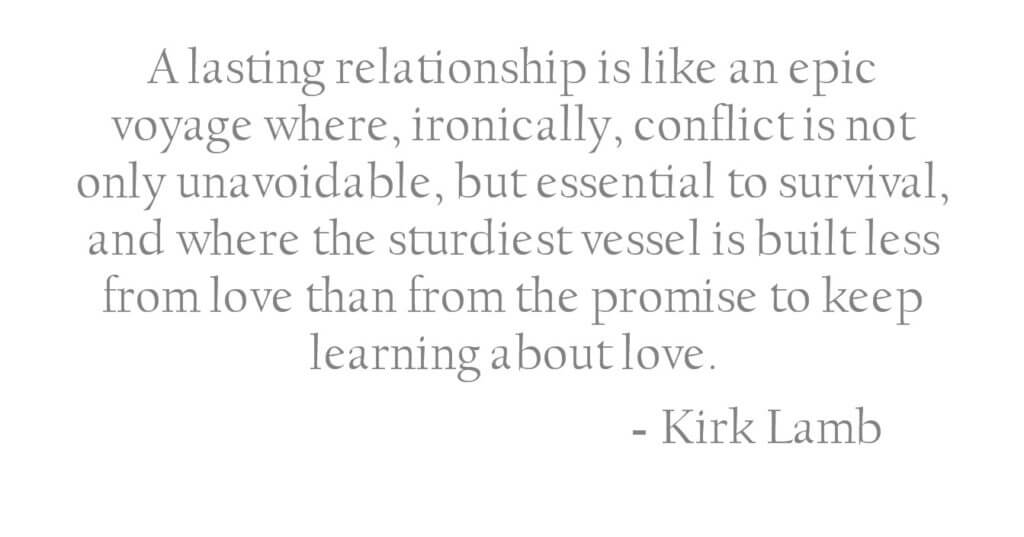Fellowship of the Rings: Common Sense Wisdom for Lasting Marriages: Part 2

By: Kirk Lamb, PhD., LP, Licensed Psychologist
© 2005 - 2018 Kirk Lamb, Ph.D., Author, for text, drawings, and photographs
© 2024 Bonnett Chandler, MA, LPCC,
Richard Chandler, MA, LPC, Kelly Krueger, MA, LMFT
Note: This marriage and couples relationship e-book is also available as a 40-page booklet for $7.95. If you wish to purchase a copy to give to an engaged couple, simply contact Richard Chandler.
All rights reserved worldwide. Rights of reproduction in any medium are prohibited without the written permission of the publisher.
Author’s Note: Each of the ideas presented in this ebook has something to do with how lasting couples create fellowship and, through it, the emotional safe-haven essential to their success.
Not Just Sex
One of the most basic ways enduring couples protect their experience of a safe emotional bond is by mutual intimate touch.
Couples in lasting marriages often treat their physical relationship as if it were a kind of sacred practice that nurtures the relationship’s need for mutual tenderness, playfulness, intimacy, privacy, sensuality, and joy.
They protect it both fiercely and creatively, even when small children and work leave them weary and without much time or energy. It is not viewed as just sex or a duty to be performed.
Feeding and Protecting the Couple Friendship
In general, women and men in working relationships don’t assume the friendship just takes care of itself. Like a child, they take care of it. Dr. Gottman’s 25-year follow-up research on married couples revealed several fundamental ways that lasting couples protected their friendship including:
- Sharing Information. Couples in marriages that work continuously exchange and remember information about the important things in each other’s lives. They try to know their spouse. From small things like remembering to ask about how something went at work today, to gaining a specific understanding of who the most important people were to their spouse when a child, partners in enduring marriages keep drawing a respectful ‘map’ of each other’s life.
- Expressing Fondness and Appreciation. Lasting couples communicate fondness and appreciation on a fairly frequent basis. They contribute to one another’s sense that they are viewed as lovable, valued, and capable in some way.
Keeper Two: Learn How to Face, Not Avoid, Conflicts By “Getting To the Hurt”
“The number one predictor of divorce is the habitual avoidance of conflict.” This is the surprising conclusion drawn by the ‘Coalition For Marriage and Couples Education’ (see www.smartmarriages.com.) If magically, I could give a couple just one thing to increase their chances for a loving and enduring relationship, it would be this: the capacity to manage conflicts and turn them into signals for repairing their connection. Note that I am not at all suggesting that conflict and anger be stifled or avoided. A couple will inevitably become stuck in the middle phases of their journey if they fail to use conflict to learn how to nurture their emotional bond. Obviously, out-of-control conflict is a boisterous tyrant that kills a couple’s ability to solve the problems of living together. But, likewise, over-controlled or avoided conflict can become a passive tyrant who brings a slow, insidious relationship death.
Couples, who have healthy, working partnerships, somehow use conflict as a dangerous opportunity to deepen or at least repair their emotional bond. But couples who consistently avoid conflict fail to seize this opportunity. If a conflict is consistently avoided, bids for the feeling of connection are likely to become dysfunctional and may go underground (as in depression, estrangement, addictions, pornography, affairs, etc.).
Emotional Flooding And The Hijacked Brain
The notion of emotional flooding (overwhelming negative emotion) has received a great deal of attention in recent research on relationship conflict. This research helps us understand more fully why facing conflict can be extremely difficult for many of us. Basically, when we are confronted with a situation we interpret as somehow threatening to the security of our emotional connection with our partner, our thoughtful brains (cerebral cortex) may get ‘hijacked’ by our emotional brains (the limbic system).
Our cerebral cortex (the reflective, insightful part of our brains) may get temporarily, but effectively, shut down. When fast-acting neurochemical messengers are sent from the emotional brain’s memory bank, they simultaneously stifle higher brain functioning and flood our bodies with powerful chemicals (like adrenaline and cortisone). These chemicals trigger any or all of three basic reactions: Fight, Flight and Freeze (the “F trio”.)
Once emotional flooding has occurred, we lose some important capabilities if we are involved in a disagreement with our spouse. And it may take hours or even a day for the body chemistry to return to a more thoughtful, reasonable state.
Dr. Daniel Wylie, a well-known expert on marital conflict, indicates that, when we flood, we lose our abilities to listen, reason logically, understand, remain objective and show compassion and empathy. Dialogue disappears. We lose the right words, perhaps all words, and, if we find any, they serve our need to protect ourselves through the F trio. An excellent resource for those wanting to learn how to better manage their flooding tendencies is a book by Jacobs-Stewart, “Paths Are Made By Walking,” referenced at the end of this booklet.
Getting to the Hurt: Moving From ‘Dangerous’ to ‘Scared’
Couples who face conflict well “get to the hurt.” In so doing, they redefine the relationship as a safe haven once again. By this I mean they slog through the angry accusations and lengthy silent frustrations while still remaining present to one another and the issue at hand.
Eventually, they come to understand the real hurt: that each had felt a threat to the emotional bond during the argument. Partners go from being seen as dangerous to being understood as scared. This is the turning point where damage to the bond has a chance to trigger repair or even deepen the bond. It may not be pretty, it may be slow and clumsy, but, after a while, it happens.
For example, a couple on a two-week vacation had an animated argument early in their first day. The woman was furious at the man’s insistence on stopping every half hour or so to eat at expensive tourist restaurants or street vendors. He thought the argument was about her fear of running out of money.
Although he eventually admitted he had no idea how much he had been spending on food, he still felt entitled to keep himself sufficiently ‘fueled’ so he could enjoy all of the walking. Not until later, did he begin to understand and respect how all his stops were triggering her dread that they would run out of time (as well as money) to explore the beautiful countryside.
Traveling the world was a dream deeply connected to her childhood frustrations about being trapped in her family culture and a small town which felt oppressive to her. While her husband’s support of travel reassured her that he was in tune with and committed to her, his time and money-wasting delays triggered alarms that his support was weaker than she had thought.
After an intense conversation, the purchase of a large cache of SnickersTM bars for his backpack became a welcome compromise solution. A ‘dangerous’ conversation finally revealed it’s truer identity - a ‘scary’ threat that their emotional bond might be weakening.

Accepting That Many Conflicts Never Really Get Completely Resolved
Marriage researcher Dr. John Gottman, has discovered that across all the couples he studied (well over one thousand), the average number of ‘perpetual’ (repeating and never really resolved) conflicts per couple was between eleven and twelve. Such conflicts are the natural and inevitable part of a couple confronting their differences and, thereby, becoming two relatively healthy individuals (Stages 2 and 3).
The most familiar ‘perpetuals’ that I see in my work with couples include:
- Differing beliefs and approaches concerning money management
- Emotional self-management, flooding with anger and anxiety
- Household chores (fairness and gender role issues)
- Parenting differences
- Trust
- Sexual needs and “appetite” differences
- In-laws
- Religious differences
- Health and appearance issues (alcohol and other addictions, depression, fitness, etc.)
Differing social life needs - Lifestyle differences (such as organized versus spontaneous, outdoor/indoor, city/country, etc.)
- Different opinions about getting help for serious personal or couple problems
Couples in lasting relationships do not necessarily avoid or solve problems in these conflict areas. Rather, they learn how to face them as ongoing high-risk areas which have to be repeatedly quieted and transformed into less dominant aspects of their lives.
Successful Couples Have Overt or Implicit Emotional Safety Rules When Arguments Occur

Having some sort of simple rules of engagement when it comes to disagreements gives the couple a precious thing: a time to cool off and reclaim the rest of the brain that may have been hijacked. Constructive conflicts need time to move from first reactions, which are often clumsy protective efforts, to a little more self-awareness and, eventually, compassion.
Time allows us to ‘get to the hurt’, (both our own and our partner’s.) Couples in working partnerships often (but definitely not always) find ways to stay present even though they are somewhat flooded with negative emotions.
They may have discovered that a major argument doesn’t mean the end of the relationship and the annihilation of feeling safe. With the help of basic ground rules, they find ways to calm down enough to simply ‘hang in there’, even if they have no solutions or even any words at all. Long silences with two people sitting on opposite sides of the kitchen table can, surprisingly, be one of the best signs that a good argument is occurring.
Just as there can be no baseball game without agreement as to what’s fair or foul, there can be no safety in a marriage without some kind of trust in a mutual adherence to what’s ok and what’s not ok in an argument.
The following are some of the ground rules couples have shared with me:
It is important to remember that what works for one couple may not for another, and what works at one stage in a marriage may have to be replaced at another.
- No physical violence of any kind by either partner is ever acceptable!
- No walking out unless a temporary ceasefire is mutually agreed to. (In some situations, if a person knows he or she is at high risk of becoming violent or has strong reason to believe he or she is at risk of being violated physically, then a unilateral distancing is obviously required.) If a cooling-off period is needed by one or both partners, the matter is not just dropped and avoided, but is faced later.
- No insisting on the perfect agreement. It’s OK if agreement or consensus is never reached about certain things.
- No name calling, contemptuous sarcasm, destructive teasing, stonewalling and ‘diagnosing’ the other’s mental health or simply their ‘true’ motivations.
- No bringing up old arguments until the present one is finished.
- No to some topics. Certain topics are assigned to an out-of-bounds category for fighting either permanently or for a particular period of time. For example, topics over which neither partner has much control: religion, body type, the character of some one’s parent, or a person’s tastes in foods.
Keeper Three: Avoid Financial Infidelity Every Bit As Much As Romantic Infidelity
Any discussion of ways to prevent romantic infidelity is well beyond the scope of this article (an excellent book on this, “Not Just Friends” by Shirley Glass, is referenced later). It is, however, crucial for most partners to understand that there are two major kinds of infidelity: emotional/sexual and financial. You may be surprised at the concept of financial infidelity. This refers to an ongoing practice of deliberate secrecy regarding either 1. spending, 2. earning or 3. saving money.

Even more surprising is the fact that repeated betrayals of trust concerning the earning, spending or saving of money can have just as much negative impact on a couple’s chances to survive as do emotional or even sexual betrayals.
A recent article in the New York Times in this area was aptly titled: “Til Debt Do Us Part”. (One of the best resources concerning couples and their handling of money conflict is Ruth Hayden’s “For Richer, Not Poorer,” referenced later)
Keeper Four: Achieve a Positive “Divorce” From Families of Origin and Previous Partners and Thereby Honor the Primacy of The Couple Bond
“Divorce” sounds pretty negative. What I am getting at is this: in relationships that work, there arises a clear sense that, basically, “We two are giving birth to our own thing here.”I am by no means suggesting a forced, negative cutoff- but rather, a normal evolution toward ‘adult to adult’ relationships." A healthy psychological separation from families of origin and any previous marriages (i.e., good boundaries) is gradually achieved over a period of time. Both partners eventually feel that the new couple family has now become, without question, the primary family in their lives. They know this has occurred when there is significantly more emotional intensity and positive energy among those in the new family than between the partners and their parents, siblings, and any previous partners. If a healthy maturation toward adult-adult relationships with families of origin does not develop, the strength of the partnership bond can be tragically undermined.
The following are just a few samples of very common practices which can inadvertently damage the development of a strong partnership:
- One partner makes obligatory daily calls to a parent and talks extensively about the couple’s tensions, challenges, and difficulties.
- One spouse’s mother enduringly monopolizes the way a first child is raised.
A partner spends more time most weekends with brothers, sisters or other extended families than with his or her spouse. - A spouse works in a family business where there is little separation between family roles, business roles, and finances.
Since stronger boundaries between a couple and their original families usually present very difficult trade-offs for a couple, it can take years of pulling away – reconnecting - pulling away - reconnecting until a redefined, respectful new relationship has evolved. Along the way, it may be difficult to discourage the handy-man father-in-law from coming over so often to help with home improvement projects (saving the couple money and giving him a renewed purpose in retirement).
Likewise, a decision not to use nearby grandparents quite so often as babysitters might feel like cruel and unusual punishment to them (not to mention the financial pain and inconvenience for the couple by not doing so). Finally, it may be touchy if a couple starts to originate their own holiday traditions that naturally bring reduced contact with original families.
This redirection of family energy forces the new couple to create a partnered lifeless constrained by powerful triangles with in-laws and former spouses or lovers. The partners are challenged to invent solutions that suit their own particular personalities and life circumstances and then borrow selectively, rather than wholesale, from the knowledge and skills of past families. The result can be a sense of shared authorship and ownership of the marriage.
Keeper Five: Honor One Another’s Personal Dreams and Remain Sensitive To One Another’s Deepest Dreads
In my work with couples, I urge life partners to become “Dream Detectors”, a phrase coined by Dr. Gottman. His research clearly shows that couples form and maintain “much more positive emotional connections when they encourage one another’s dreams and aspirations.”
This results in what he calls “shared meanings.” These create the common emotional ground that motivates them to stay in a relationship even when their bond is “wracked with conflict” and stress.
People “hang in there” because their relationship is part of what makes their lives significant. In a similar vein, remaining sensitive to our partner’s deepest fears, often rooted in childhood pain and possibly confusing to us, can be an essential ingredient in maintaining emotional safe haven.
Revisiting the ‘vacation food fight’ example mentioned earlier, we learn that for many years the wife offered unwavering support for her husband’s hobby of photography and he gave equally longstanding support of her dream of world traveling. Since both of their interests were expensive, over time they could have created a competition for the pieces of the couple’s limited financial pie. She could have felt him “stepping on” her dream of traveling, which was matched by her life-long dread of feeling trapped in one place.
He could have experienced her stepping on his lifelong desire to reconnect with the artist he had left behind. Support of a partner’s detected personal dreams is a powerful way to build an “emotional bank account” which creates a sense of safe haven from which a couple can draw whenever the bond gets bruised.
A Final Word About Creating Lasting Romantic Partnerships
In this ebook, I have likened a lasting relationship to an epic voyage where, ironically, conflict is not only unavoidable, but essential to survival, and where the sturdiest vessel is built less from love than from the promise to keep learning about love.
I have encouraged couples to see more fear than danger in their partner’s eyes whenever conflict announces that their bond is hurting and needs repair.
I have described what I call fellowship keepers: five practices that nourish couple resilience by creating and recreating a kind of emotional safe haven. These five, though among the most important, hardly make up a comprehensive list of practices common to healthy marriages.
Finally, rather than address the multilayered meanings, family politics and subtle complexities of long-term relationships, I have, instead, tried only to offer a basic ‘users guide’ for new and renewing couples.
References
THE SEVEN PRINCIPLES FOR MAcING MARRIAGE WORK by John Gottman and Nan Silver, Crown Publishers, 1999, paperback
THE RELATIONSHIP CURE by John Gottman and Joan DeClaire, Three Rivers Press, New York, 2001
TEN LESSONS TO TRANSFORM YOUR MARRIAGE by John and Julie Schwartz Gottman, Crown Publishing, 2006-11-12
THE PRACTICE OF EMOTIONALLY FOCUSED COUPLES THERAPY, 2ND EDITION, by Susan Johnson, Routledge Publishing, 2004
ATTACHMENT PROCESSES IN COUPLE AND FAMILY THERAPY by Susan Johnson and Valerie Whiffen, Guilford Press, 2003
THE GOOD MARRIAGE: HOw AND WHY LOVE LASTS, by Judith Wallerstein and Sandra Blakeslee, Houghton Mifflin Co., 1995
AFTER THE FIGHT: USING YOUR DISAGREEMENTS TO BUILD A STRONGER RELATIONSHIP, by Daniel Wylie, The Guilford Press, 1993
GROW UP! HOW TAKING RESPONSIBILITY CAN MAKE YOU A HAPPY ADULT by Frank Pitman, M.D., Golden Books, 1998
REMARRIAGE AND AFTER by Emily and John Visher, Stepfamily Association of America & National Stepfamily Resource Center (NSRC) www.stepfamilies.info.
FOR RICHER, NOT POORER—THE MONEY BOOK FOR COUPLES by Ruth Hayden, Health Communications, Inc., Deerfield Beach, Florida
NOT “JUST FRIENDS”: PROTECT YOUR RELATIONSHIP FROM INFIDELITY AND THE TRAUMA OF BETRAYAL by Shirley Glass and Jean Staeheli, Free Press, 2002
PATHS ARE MADE BY WALKING: PRACTICAL STEPS FOR ATTAINING SERENITY. Therese Jacobs-Stewart, Warner Books, 2003
THE LORD OF THE RINGS (IN THREE PARTS) by J. R. R. Tolkien, Ballantine Books, New York, 1965
